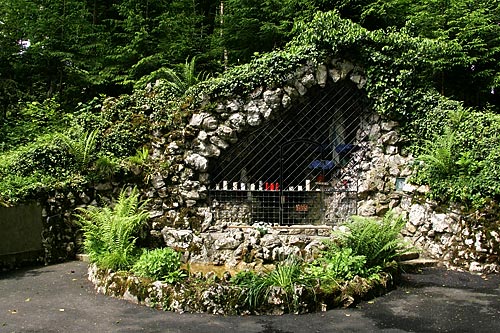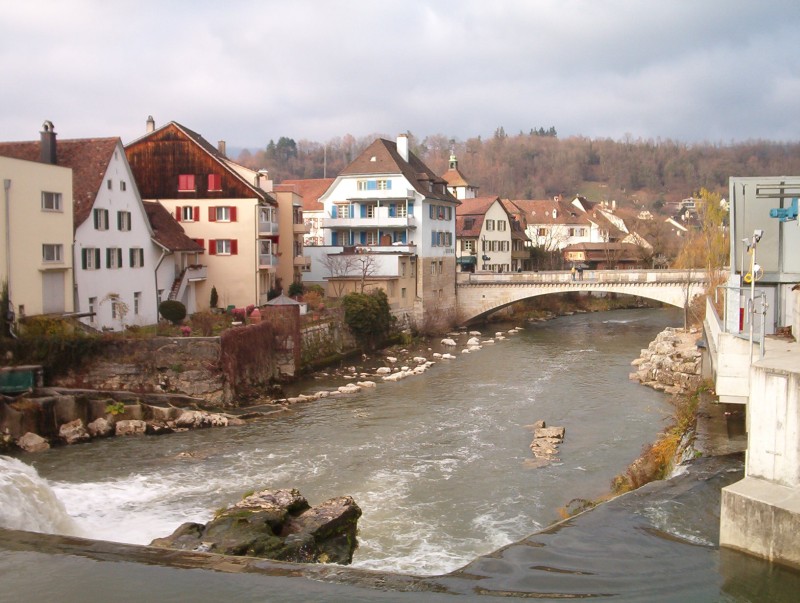|
Bärschwil
Bärschwil is a village and municipality in the district of Thierstein in the canton of Solothurn in Switzerland. History Bärschwil is first mentioned in 1194 as ''Bermeswile''. From the 19th century until 1957, Bärschwil was a source of gypsum. Initially, the gypsum was extracted on the surface but, subsequently, using underground mines accessed via adits. Until 1910, the mine was situated at Gupf and, when that was exhausted, a new mine was opened at Kirchacker. In 1875, the Jura railway line was opened at the northern edge of Bärschwil municipality, and a station opened. Between 1894 and 1952, the gypsum mines were linked to the station by the Bärschwil gypsum railway, a narrow gauge line which used a combination of horse haulage and gravity. Geography Bärschwil has an area, , of . Of this area, or 41.4% is used for agricultural purposes, while or 52.9% is forested. Of the rest of the land, or 5.0% is settled (buildings or roads), or 0.2% is either rivers or ... [...More Info...] [...Related Items...] OR: [Wikipedia] [Google] [Baidu] |
Bärschwil Gypsum Railway
The Bärschwil gypsum railway (german: Gipsbahn Bärschwil) was a narrow gauge railway in the Swiss canton of Solothurn. It existed from 1894 to 1952, carrying gypsum from mines in the village of Bärschwil to that village's former railway station some distance away on the Jura railway line. The mines have now been closed and filled in, but some of the line's route through the village can be identified. Between the village and the station, much of the line's right of way is now occupied by a geologically themed hiking trail, which also crosses the four span metal girder bridge that is the line's main surviving relic. History From the 19th century, Bärschwil was a source of gypsum. Initially the gypsum was extracted on the surface, but subsequently using underground mines accessed via adit An adit (from Latin ''aditus'', entrance) is an entrance to an underground mine which is horizontal or nearly horizontal, by which the mine can be entered, drained of water, ventilated, a ... [...More Info...] [...Related Items...] OR: [Wikipedia] [Google] [Baidu] |
Thierstein (district)
Thierstein District is one of the ten districts of the canton of Solothurn in Switzerland, situated to the north of the canton. Together with the Dorneck District, it forms the ''Amtei'' (electoral district) of Dorneck-Thierstein. It has a population of (as of ). Municipalities Thierstein District contains twelve municipalities, with Kleinlützel existing as an exclave. Geography Thierstein has an area, , of . Of this area, or 40.5% is used for agricultural purposes, while or 52.2% is forested. Of the rest of the land, or 6.9% is settled (buildings or roads), or 0.1% is either rivers or lakes and or 0.2% is unproductive land.Swiss Federal Statistical Office-Land Use Statistics 2009 data accessed 25 March 2010 Of the built up area, housin ... [...More Info...] [...Related Items...] OR: [Wikipedia] [Google] [Baidu] |
Courchapoix
Courchapoix is a municipality in the district of Delémont in the canton of Jura in Switzerland. History Courchapoix is first mentioned in 1435 as ''Curchappoix''. Geography Courchapoix has an area of . Of this area, or 52.4% is used for agricultural purposes, while or 45.1% is forested. Of the rest of the land, or 3.0% is settled (buildings or roads), or 0.3% is either rivers or lakes.Swiss Federal Statistical Office-Land Use Statistics 2009 data accessed 25 March 2010 Of the built up area, housing and buildings made up 1.7% and transportation infrastructure made up 1.1%. Out of the forested land, 40.8% of the total land area is heavily forested and 4.2% is covered with orchards or small clusters of trees. Of the agricultural land, 26.0% is ... [...More Info...] [...Related Items...] OR: [Wikipedia] [Google] [Baidu] |
Courroux
Courroux (french: Courroux, ; fc, Corrou) is a municipality in the district of Delémont in the canton of Jura in Switzerland. History Courroux is first mentioned in 1146 under its German name as '' Lütoltesdorf''. The French name was first mentioned in 1148 as ''Corolt''. Geography Courroux has an area of . Of this area, or 53.3% is used for agricultural purposes, while or 38.4% is forested. Of the rest of the land, or 7.5% is settled (buildings or roads), or 0.6% is either rivers or lakes and or 0.3% is unproductive land.Swiss Federal Statistical Office-Land Use Statistics 2009 data accessed 25 March 2010 Of the built up area, housing and buildings made up 4.8% and transportation infrastructure made up 1.7%. Out of the forested land, 36. ... [...More Info...] [...Related Items...] OR: [Wikipedia] [Google] [Baidu] |
Grindel
Grindel (french: Grandelle) is a municipality in the district of Thierstein in the canton of Solothurn in Switzerland. History Grindel is first mentioned in 1147 as ''Crindil''. Geography Grindel has an area, , of . Of this area, or 41.2% is used for agricultural purposes, while or 50.0% is forested. Of the rest of the land, or 6.5% is settled (buildings or roads) and or 0.3% is unproductive land.Swiss Federal Statistical Office-Land Use Statistics 2009 data accessed 25 March 2010 Of the built up area, housing and buildings made up 4.2% and transportation infrastructure made up 2.0%. Out of the forested land, 43.1% of the total land area is heavily forested and 6.9% is covered with orchards or small clusters of trees. Of the agricultural land, 2 ... [...More Info...] [...Related Items...] OR: [Wikipedia] [Google] [Baidu] |
Laufen, Basel-Country
Laufen ( French: ''Laufon'' ; High Alemannic: ''Laufe'') is a municipality and the capital of the district of Laufen in the canton of Basel-Country in Switzerland. Laufen is a principal train station for the surrounding area, connecting it to Basel. History Between 58 BC and 470 AD, Laufen was part of the Roman Empire; after the empire collapsed it was part of the Alemanish area for several decades. During the early sixth century, the entire valley came into the possession of France, and from 853 until 1033 it was part of the Burgundian Kingdom. In 999 Rudolf III, the childless king of Burgundy donated most of the Laufen valley territory to the Archbishopric of Basel. Laufen is first mentioned in 1141 as ''Loufen''. For a time, it was known by its French name ''Laufon''. In 1295 founded the small town of Laufen. Geography Laufen has an area, , of . Of this area, or 27.0% is used for agricultural purposes, while or 52.8% is forested. Of the rest of the land, or 18 ... [...More Info...] [...Related Items...] OR: [Wikipedia] [Google] [Baidu] |
Liesberg
Liesberg is a municipality in the district of Laufen in the canton of Basel-Country in Switzerland. History Liesberg is first mentioned in 1281 as ''Liesperch''. Geography Liesberg has an area, , of . Of this area, or 36.6% is used for agricultural purposes, while or 53.3% is forested. Of the rest of the land, or 8.8% is settled (buildings or roads), or 0.5% is either rivers or lakes and or 1.0% is unproductive land.Swiss Federal Statistical Office-Land Use Statistics 2009 data accessed 25 March 2010 Of the built up area, industrial buildings made up 1.4% of the total area while housing and buildings made up 2.9% and transportation infrastructure made up 3.0%. Power and water infrastructure as well as other special developed areas made up 1.3% ... [...More Info...] [...Related Items...] OR: [Wikipedia] [Google] [Baidu] |
Montsevelier
Montsevelier () is a former municipality in the district of Delémont in the canton of Jura in Switzerland. The municipalities of Montsevelier, Vermes and Vicques merged on 1 January 2013 into the new municipality of Val Terbi.Amtliches Gemeindeverzeichnis der Schweiz published by the Swiss Federal Statistical Office accessed 2 January 2013 History Montsevelier is first mentioned in 1136 as ''Muzivilir''. The municipality was formerly known by its German name ''Mutzwil'', however, that name is no longer used.Geography [...More Info...] [...Related Items...] OR: [Wikipedia] [Google] [Baidu] |
Vicques, Switzerland
Vicques (; formerly german: Wix) is a former municipality in the district of Delémont in the canton of Jura in Switzerland. The municipalities of Montsevelier, Vermes and Vicques merged on 1 January 2013 into the new municipality of Val Terbi.Amtliches Gemeindeverzeichnis der Schweiz published by the Swiss Federal Statistical Office accessed 2 January 2013 Jura Observatory is located above Vicques. History Vicques is first mentioned in 866 as ''Vicum''.Geography [...More Info...] [...Related Items...] OR: [Wikipedia] [Google] [Baidu] |
Corban, Switzerland
Corban () is a former municipality in the district of Delémont in the canton of Jura in Switzerland. On 1 January 2018 the former municipality of Corban merged into the municipality of Val Terbi. History Corban is first mentioned in 1184 as ''Bathendorf''. In 1240 it was mentioned as ''Corpaon''. Geography Corban has an area of . Of this area, or 62.5% is used for agricultural purposes, while or 33.1% is forested. Of the rest of the land, or 4.5% is settled (buildings or roads), or 0.1% is either rivers or lakes and or 0.3% is unproductive land.Swiss Federal Statistical Office-Land Use Statistics 2009 data accessed 25 March 2010 Of the built up area, housing and buildings made up 2.7% and transportation infrastructure made up 1.4%. Out of ... [...More Info...] [...Related Items...] OR: [Wikipedia] [Google] [Baidu] |
French Language
French ( or ) is a Romance language of the Indo-European family. It descended from the Vulgar Latin of the Roman Empire, as did all Romance languages. French evolved from Gallo-Romance, the Latin spoken in Gaul, and more specifically in Northern Gaul. Its closest relatives are the other langues d'oïl—languages historically spoken in northern France and in southern Belgium, which French ( Francien) largely supplanted. French was also influenced by native Celtic languages of Northern Roman Gaul like Gallia Belgica and by the ( Germanic) Frankish language of the post-Roman Frankish invaders. Today, owing to France's past overseas expansion, there are numerous French-based creole languages, most notably Haitian Creole. A French-speaking person or nation may be referred to as Francophone in both English and French. French is an official language in 29 countries across multiple continents, most of which are members of the ''Organisation internationale de la Francophonie'' ... [...More Info...] [...Related Items...] OR: [Wikipedia] [Google] [Baidu] |
Coat Of Arms
A coat of arms is a heraldry, heraldic communication design, visual design on an escutcheon (heraldry), escutcheon (i.e., shield), surcoat, or tabard (the latter two being outer garments). The coat of arms on an escutcheon forms the central element of the full achievement (heraldry), heraldic achievement, which in its whole consists of a shield, supporters, a crest (heraldry), crest, and a motto. A coat of arms is traditionally unique to an individual person, family, state, organization, school or corporation. The term itself of 'coat of arms' describing in modern times just the heraldic design, originates from the description of the entire medieval chainmail 'surcoat' garment used in combat or preparation for the latter. Roll of arms, Rolls of arms are collections of many coats of arms, and since the early Modern Age centuries, they have been a source of information for public showing and tracing the membership of a nobility, noble family, and therefore its genealogy across tim ... [...More Info...] [...Related Items...] OR: [Wikipedia] [Google] [Baidu] |



